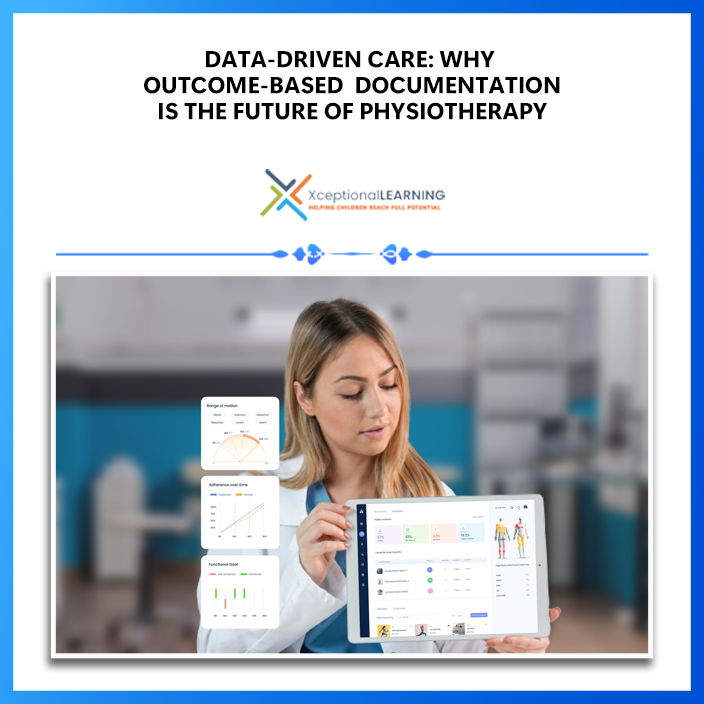Data-Driven Care: Why Outcome-Based Documentation Is the Future of Physiotherapy
admin August 19th, 2025

In today’s evolving healthcare environment, data-driven care has shifted from a forward-thinking idea to an essential part of everyday physiotherapy practice. With increasing demands for accountability, efficiency, and patient satisfaction, outcome-based documentation is revolutionizing how physiotherapy is delivered and evaluated. Moving beyond subjective progress notes, this approach applies measurable outcomes to guide treatment decisions, monitor patient progress, and justify services. For physiotherapists, adopting outcome-based documentation means elevating clinical practice while aligning with broader healthcare goals. This blog explores the importance of data in physiotherapy, the benefits of outcome-based documentation, challenges in implementation, digital tools that support this shift, and how physiotherapists can embrace a data-driven future.
Understanding Outcome-Based Documentation in Physiotherapy
Outcome-based documentation involves recording and evaluating patient progress using measurable clinical outcomes. Unlike traditional narrative-style documentation, this approach quantifies therapy results using standardized assessment tools, patient-reported outcome measures (PROMs), and functional performance metrics.
Examples of outcome-based tools in physiotherapy include:
- Visual Analog Scale (VAS) for pain
- Timed Up and Go (TUG) test for mobility
- Oswestry Disability Index (ODI) for low back pain
- Berg Balance Scale for assessing balance
- 6-Minute Walk Test (6MWT) for endurance
These tools provide physiotherapists with concrete data to:
- Set treatment goals
- Track improvement
- Adjust interventions based on results
- Communicate value to payers and patients
Why Is Data-Driven Care Important in Physiotherapy?
- Enhancing Treatment Effectiveness: Data-driven care ensures that therapy is goal-oriented and adaptive. By consistently documenting and analyzing patient outcomes, physiotherapists can fine-tune interventions, discard ineffective methods, and personalize treatment plans, resulting in faster recovery and optimized care delivery.
- Boosting Patient Engagement: When patients can visually track their progress through measurable outcomes, such as charts, progress scores, or milestones, they become more motivated and invested in their recovery. This transparency encourages a sense of ownership and develops stronger adherence to therapy protocols.
- Fulfilling Insurance and Regulatory Requirements: In today’s healthcare landscape, insurance providers and regulators demand clear evidence of treatment effectiveness. Outcome-based documentation provides verifiable proof of progress, helping justify continued care, streamline approval processes, and minimize claim rejections.
- Promoting Accountability and Transparency: Using data to guide physiotherapy promotes a culture of accountability. Therapists can demonstrate the impact of their interventions, building trust with patients, families, and institutions while enhancing their professional credibility through transparent reporting.
- Advancing Research and Evidence-Based Practice: Collecting and analyzing outcome data contributes to broader clinical research. It allows clinics to benchmark performance, refine treatment protocols, and support the development of best practices, strengthening the overall quality and scientific foundation of physiotherapy services.
Key Benefits of Outcome-Based Documentation
- Streamlined Clinical Decision-Making: Data-driven care empowers physiotherapists to make informed decisions based on real-time feedback. Adjustments to treatment plans are no longer speculative—they are evidence-based.
- Efficient Resource Utilization: With measurable data, therapists can allocate therapy sessions more efficiently, focusing on areas of greatest need. This reduces wasted time and enhances productivity.
- Quality Improvement and Benchmarking: Clinics can analyze treatment outcomes across different therapists, patient populations, or conditions. This leads to quality assurance, standardization, and improved clinical outcomes.
- Regulatory Compliance and Accreditation: Many regulatory bodies now require outcome tracking as part of quality assurance. Clinics that adopt data-driven documentation are better prepared for audits, accreditation, and funding opportunities.
- Facilitating Multidisciplinary Collaboration: Outcome data enables smoother communication with other healthcare professionals. Shared metrics allow doctors, nurses, and therapists to align on care plans, improving overall patient outcomes.
Digital Tools Enabling Data-Driven Physiotherapy
Technology is central to implementing outcome-based documentation. Various digital platforms and tools support physiotherapists in tracking, analyzing, and reporting patient outcomes efficiently.
- Electronic Health Records (EHRs): Modern EHR systems help to integrate standardized outcome measures into documentation templates. They streamline data entry, flag progress automatically, and generate outcome reports.
- Therapy Management Software: Platforms tailored for rehab services often feature in-built PROMs, scoring systems, and analytics dashboards. This allows for quicker assessments and visual feedback to patients.
- Mobile Apps and Wearables: Apps can collect real-time data from patients doing home exercises. Wearables provide insights into gait, mobility, and activity levels, enhancing the accuracy of treatment outcomes.
- Patient Portals and Dashboards: Digital portals enable patients to self-report symptoms, track improvement, and communicate goals. Therapists can visualize progress over time and adapt plans accordingly.
Overcoming Challenges in Implementation
While the benefits are clear, transitioning to outcome-based documentation can be challenging. Here’s how to address common barriers:
- Time Constraints
- Solution: Use integrated digital tools that minimize manual entry and automate scoring. Templates, voice-to-text, and checklists can speed up documentation.
- Resistance to Change
- Solution: Offer training and workshops highlighting the clinical and financial benefits. Celebrate early successes and encourage peer mentorship.
- Lack of Standardization
- Solution: Choose widely recognized condition-specific outcome measures. Align documentation protocols across therapists for consistency.
- Cost of Technology
- Solution: Start with affordable cloud-based platforms or hybrid solutions like XceptionalLEARNING Platform for small clinics. These platforms provide free trials and scalable pricing models, offering flexible solutions that grow with your clinic’s needs.
- Data Privacy Concerns
- Solution: Ensure compliance with data protection laws (e.g., HIPAA or GDPR) when using digital platforms. Choose tools with secure encryption and patient consent protocols.
Future Trends in Physiotherapy Documentation
- AI-Driven Analytics: Artificial intelligence will analyze large datasets to predict treatment outcomes, flag anomalies, and recommend interventions. This reduces guesswork and personal bias in clinical decision-making.
- Predictive Outcome Modeling: Advanced systems will forecast likely recovery trajectories based on patient demographics, conditions, and previous outcomes. Therapists can set realistic expectations and optimize care plans.
- Blockchain for Secure Documentation: Blockchain can offer tamper-proof recordkeeping and transparent data sharing, improving trust and legal compliance in healthcare documentation.
- Integration with Teletherapy Platforms: With telehealth rising, outcome-based tools will become embedded into virtual therapy platforms, ensuring remote sessions are as data-driven as in-clinic care. The XceptionalLEARNING Platform is an example, offering real-time progress tracking and personalized treatment for remote therapy sessions.
- Gamified Patient Engagement: Gamified feedback on outcomes, like progress badges or performance levels, will boost patient engagement and adherence to therapy.
How Physiotherapists Can Embrace the Change
- Start Small: Introduce 1-2 outcome measures for your most common patient conditions.
- Train Your Team: Conduct in-house training sessions on the value and use of outcome documentation tools.
- Choose the Right Tools: Select platforms that align with your clinical workflow and support mobile or tablet-based documentation like VergeTAB.
- Involve Patients: Make outcome discussions a part of therapy sessions. Share progress visually and celebrate improvements.
- Monitor and Adapt: Regularly review outcome trends and adapt your clinical practices accordingly.
Conclusion: The Way Forward with Outcome-Based Documentation
In an era of value-based care, outcome-based documentation is not just an administrative tool—it is the foundation of effective, patient-centered physiotherapy. By embracing data-driven practices, physiotherapists can deliver higher-quality care, demonstrate clinical value, improve patient outcomes, and future-proof their practices against shifting healthcare demands. XceptionalLEARNING is bridging the gap between traditional therapy and modern data integration with digital tools like Digital Activity Book, real-time progress dashboards, and remote therapy access. If you’re ready to transform your clinic with digital documentation and measurable impact, contact us today, request a demo, or let our team of experts guide you toward smarter physiotherapy solutions. With our Best Physiotherapy Services and focus on Child Development Support, we ensure personalized care through evidence-based practices tailored to every patient’s needs. The future of physiotherapy is evidence-based, and the time to act is now.

